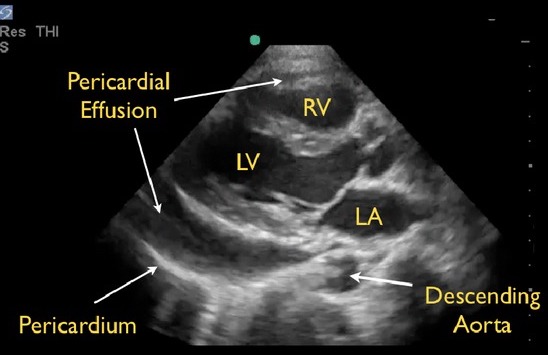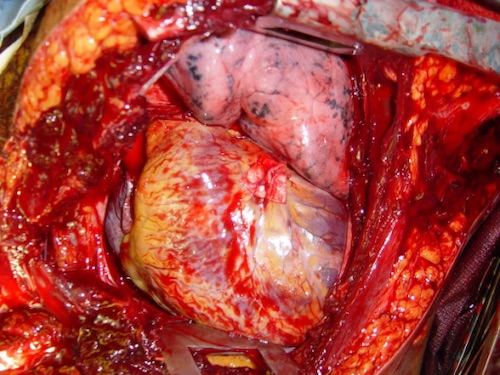Cardiac Laceration
Cardiac Laceration
David Ray Velez, MD
Table of Contents
Presentation
The Majority of Penetrating Cardiac Injuries are Simple Lacerations
Penetrating Cardiac Trauma Has High Mortality – Only 25-50% Survive to the Hospital
Chambers
- Right Ventricle is the Most Common Injured Chamber (Due to Anterior Position)
- Left Atrium is the Least Common Injured Chamber (Due to Posterior Position)
Muscular Ventricle May Seal Lacerations Preventing Exsanguination Prior to Arrival
Most Common Vessel Injured: Left Anterior Descending (LAD)
Coronary Artery Injury Can Cause Cardiac Ischemia and Myocardia Infarction (MI)
Cardiac Tamponade
- Stab Wounds – Up to 80 will Eventually Cause Tamponade
- Gun Shot Wounds – Have Larger Pericardial Defects and are More Commonly Associated with Hemorrhage than Tamponade
- Freely Bleeding Coronary Arteries Can Cause Tamponade
- Development of Pericardial Tamponade May Have a Protective Effect from Exsanguination and Has Shown Higher Survival Rates
- *See Cardiac Tamponade
Diagnosis
Diagnosis Requires a High Index of Suspicion
Physical Exam Findings in General are Neither Highly Sensitive nor Specific
Signs of Tamponade
- Pulsus Paradoxus: Decreased BP > 10 mmHg During Inspiration (Normal < 10 mmHg)
- Inspiration Increases Venous Return and Enlarged RV Impairs LV Filling
- Beck’s Triad:
- Jugular Venous Distention (JVD)
- Muffled Heart Sounds
- Hypotension with Narrow Pulse Pressure
- Kussmaul’s Sign: JVD Upon Inspiration
Primary Testing
- Ultrasound (Echocardiography, POCUS, FAST) – The Primary Tool for Diagnostic Evaluation
- Chest Xray
- CT Scan
- EKG
Subxiphoid Pericardial Window
- *See Subxiphoid Pericardial Window
- Used in Trauma as a Diagnostic Tool, Not Therapeutic
- Less Commonly Preformed Now; But Consider if FAST is Equivocal

Pericardial Effusion on POCUS 1
Treatment
Cardiac Laceration Requires Emergent Surgical Repair
Exposure
- Median Sternotomy is Generally Preferred
- Left Anterolateral Thoracotomy if in Cardiac Arrest (If Indicated)
Options for Temporary Control
- Digital Pressure
- Satinsky Vascular Clamp – for Atrium Defects
- Foley Balloon Catheter – Insert into the Defect and Inflate with Gentle Retraction to Occlude the Defect
- Skin Stapler
Definitive Repair
- Most Injuries Can Be Repaired by Simple Cardiorrhaphy (Primary Repair)
- Suture:
- Non-Absorbable Monofilament Suture (Prolene)
- Pledgets – Used to Prevent Tearing of the Heart
- Options: Felt, PTFE, or Own Pericardium
- Horizontal Mattress Fashion – Avoid Occluding a Coronary Artery
- With Anterior Injury, Posterior Heart Must Also Be Inspected
Coronary Artery Injury
- Proximal/Middle Injury: Coronary Artery Bypass Graft (CABG)
- Consider Primary Repair if There is No Loss of Length or Significant Narrowing
- Distal Injury: Ligation

Cardiorrhaphy with Pledgets 2
References
- Seif D, Perera P, Mailhot T, Riley D, Mandavia D. Bedside ultrasound in resuscitation and the rapid ultrasound in shock protocol. Crit Care Res Pract. 2012;2012:503254. (License: CC BY-3.0)
- Cothren CC, Moore EE. Emergency department thoracotomy for the critically injured patient: Objectives, indications, and outcomes. World J Emerg Surg. 2006 Mar 24;1:4. (License: CC BY-2.0)
